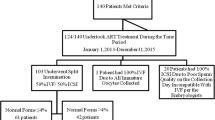Abstract
Purpose
Giant oocytes are potential sources of chromosomal abnormalities and should thus never be used in in vitro fertilization and embryo transfer (IVF-ET) procedures. The presence of giant oocytes may indicate the efficiency of the ovarian stimulation and can refer to the quality of sibling oocytes.
Methods
IVF cycles performed between January 2008 and November 2013 (n = 1521) were divided into two groups: Giant Oocyte Group (GO Group) contained cycles with at least one giant oocyte in the cohort of the retrieved oocytes (n = 37), Normal Group contained cycles with no giant oocytes (n = 1484). In the second part of the study, cycles from GO Group and Normal Group were matched according to patient age, number of retrieved oocytes and stimulation protocol, and thus 30 pairs were formed. Clinical and embryological data were analyzed.
Results
The incidence of giant oocytes was 0.3 %. The average patient age was lower (33.5 ± 3.9 vs. 35.3 ± 4.9, p = 0.02); estradiol (E2) levels (1954 ± 903 vs. 1488 ± 909 pg/l, p < 0.01) and number of retrieved oocytes (12.7 ± vs 8.1 ± 5.1, p < 0.01) were significantly higher in the GO Group. There was no difference in clinical pregnancy rates (37.8 vs. 37.4 %, p = 1.00) between the two groups. No major differences in the embryo qualities were found. In the second part of the study, fertilization rate in the matched GO Group was lower (50.6 ± 21.9 vs. 61.9 ± 22.4 %, p = 0.04). Clinical pregnancy rates (36.7 vs. 36.7 %, p = 1.00) did not differ between the matched cycles.
Conclusions
Our data suggest that the stimulation protocol does not affect the incidence of giant oocytes. Giant oocytes present in cycles with higher number of retrieved oocytes in younger women. The presence of these gametes does not refer to the quality of sibling oocytes and embryos, or the outcome of the treatment.



Similar content being viewed by others
References
Austin CR (1960) Anomalies of fertilization leading to triploidy. J Cell Comp Physiol 56:S1
Balakier H et al (2002) Morphological and cytogenetic analysis of human giant oocytes and giant embryos. Hum Reprod 17(9):2394–2401
Rosenbusch B et al (2002) Cytogenetic analysis of giant oocytes and zygotes to assess their relevance for the development of digynic triploidy. Hum Reprod 17(9):2388–2393
Machtinger R et al (2011) A giant oocyte in a cohort of retrieved oocytes: does it have any effect on the in vitro fertilization cycle outcome? Fertil Steril 95(2):573–576
Balaban B et al (2011) The Istanbul consensus workshop on embryo assessment: proceedings of an expert meeting. Hum Reprod 26(6):1270–1283
Baltz JM, Tartia AP (2010) Cell volume regulation in oocytes and early embryos: connecting physiology to successful culture media. Hum Reprod Update 16(2):166–176
Hardarson T et al (2002) A human oocyte with two sets of MII/PB-structures: Case report. Hum Reprod 17(7):1892–1894
Diedrich K et al (1994) Suppression of the endogenous luteinizing hormone surge by the gonadotrophin-releasing hormone antagonist Cetrorelix during ovarian stimulation. Hum Reprod 9(5):788–791
World Health Organization (1999) WHO laboratory manual for the examination of human semen and sperm-cervical mucus interaction, 4th edn. Cambridge University Press, Cambridge
World Health Organization (2010) WHO laboratory manual for the Examination and processing of human semen, 5th edn. WHO Press, Geneva
Veeck LL (1991) Atlas of the human oocyte and early conceptus, vol 2. Williams & Wilkins, Baltimore
Romao GS et al (2010) Oocyte diameter as a predictor of fertilization and embryo quality in assisted reproduction cycles. Fertil Steril 93(2):621–625
Conflict of interest
The authors have no conflict of interest.
Author information
Authors and Affiliations
Corresponding author
Rights and permissions
About this article
Cite this article
Lehner, A., Kaszas, Z., Murber, A. et al. Giant oocytes in human in vitro fertilization treatments. Arch Gynecol Obstet 292, 697–703 (2015). https://doi.org/10.1007/s00404-015-3679-0
Received:
Accepted:
Published:
Issue Date:
DOI: https://doi.org/10.1007/s00404-015-3679-0




